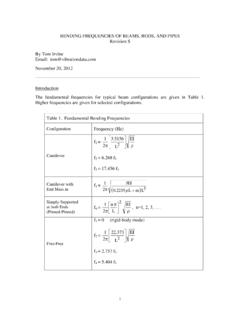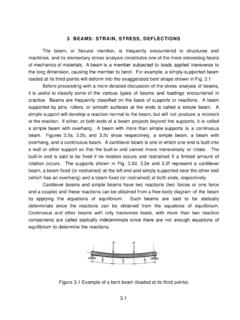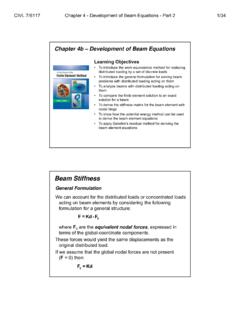Transcription of Fundamental Optics Gaussian Beam Optics
1 Fundamental OpticsGaussian beam OpticsOptical SpecificationsMaterial PropertiesOptical beam OpticsGaussian beam OpticsGaussian beam and Magnification by Simple beam beam 6/15/2009 2:53 PM Page WAIST AND DIVERGENCEIn order to gain an appreciation of the principles and limitations ofGaussianbeam Optics , it is necessary to understand the nature of the laseroutput beam . In TEM00mode, the beam emitted from a laser begins as aperfect plane wave with a Gaussian transverse irradiance profile as shownin figure The Gaussian shape is truncated at some diameter either bythe internal dimensions of the laser or by some limiting aperture in theopticaltrain. To specify and discuss the propagation characteristics of alaser beam , we must define its diameter in some way. There are twocommonlyaccepted definitions. One definition is the diameter at which thebeam irradiance (intensity) has fallen to 1/e2( percent) of its peak, oraxial value and the other is the diameter at which the beam irradianceFundamental OpticsGaussian beam OpticsOptical SpecificationsMaterial PropertiesOptical Gaussian beam OpticsGaussian beam most laser applications it is necessary to focus, modify, or shape the laserbeam by using lenses and other optical elements.
2 In general, laser-beampropagation can be approximated by assuming that the laser beam has anideal Gaussian intensity profile, which corresponds to the theoretical TEM00mode. Coherent Gaussian beams have peculiar transformation propertieswhich require special consideration. In order to select the best opticsfor a particular laser application, it is important to understand the basicproperties of Gaussian , the output from real-life lasers is not truly Gaussian (althoughthe output of a single mode fiber is a very close approximation). To accom-modate this variance, a quality factor, M2(called the M-squared factor),has been defined to describe the deviation of the laser beam froma theoretical Gaussian . For a theoretical Gaussian , M2=1; for a real laserbeam, M2>1. The M2factor for helium neon lasers is typically less ; for ion lasers, the M2factor typically is between and CollimatedTEM00diode laser beams usually have an M2ranging from to Forhigh-energy multimode lasers, the M2factor can be as high as 25 or all cases, the M2factor affects the characteristics of a laser beam andcannot be neglected in optical the following section, Gaussian beam Propagation, we will treat thecharacteristics of a theoretical Gaussian beam (M2=1); then, in the sectionReal beam Propagation we will show how these characteristics change asthe beam deviates from the theoretical.
3 In all cases, a circularly symmetricwavefront is assumed, as would be the case for a helium neon laser or anargon-ion laser. Diode laser beams are asymmetric and often astigmatic,which causes their transformation to be more in some respects component design and tolerancing for lasers ismore critical than for conventional optical components, the designs oftentend to be simpler since many of the constraints associated with imagingsystems are not present. For instance, laser beams are nearly always usedon axis, which eliminates the need to correct asymmetric are of no concern in single-wavelength lasers, althoughthey are critical for some tunable and multiline laser applications. In fact, theonly significant aberration in most single-wavelength applications isprimary (third-order) spherical from surface defects, inclusions, dust, or damaged coatings is ofgreater concern in laser-based systems than in incoherent systems. Specklecontent arising from surface texture and beam coherence can limit laser light is generated coherently, it is not subject to some of thelimitations normally associated with incoherent sources.
4 All parts of thewavefront act as if they originate from the same point; consequently, theemergent wavefront can be precisely defined. Starting out with a well-defined wavefrontpermits more precise focusing and control of the beamthan otherwise would be virtually all laser cavities, the propagation of an electromagnetic field,E(0), through one round trip in an optical resonator can be describedmathematically by a propagation integral, which has the general formwhere Kis the propagation constant at the carrier frequency of the opti-cal signal, pis the length of one period or round trip, and the integral is overthe transverse coordinates at the reference or input plane. The function Kis commonly called the propagation kernel since the field E(1)(x, y), afterone propagation step, can be obtained from the initial field E(0)(x0, y0)through the operation of the linear kernel or propagator K(x, y, x0, y0).By setting the condition that the field, after one period, will have exactlythe same transverse form, both in phase and profile (amplitude variationacross the field), we get the equation where Enmrepresents a set of mathematical eigenmodes, and gnmacorresponding set of eigenvalues.
5 The eigenmodes are referred to astransverse cavity modes, and, for stable resonators, are closely approx-imated by Hermite- Gaussian functions, denoted by TEMnm. (AnthonySiegman, Lasers)The lowest order, or Fundamental transverse mode, TEM00has aGaussian intensity profile, shown in figure , which has the formIn this section we will identify the propagation characteristics of this low-est-order solution to the propagation equation. In the next section, Real BeamPropagation, we will discuss the propagation characteristics of higher-ordermodes, as well as beams that have been distorted by diffraction or variousanisotropic beam PropagationE x y eK x y x y E x y dx dyjkpInputPlane(),,,,,100000 0 0()=()() () gnmnmnmExyKxyxyExydxdyInputPlane,,,,,() ()() 00 00 00 Ixy ekx y,() +()22( ) ( ) ( ) 6/16/2009 2:19 PM Page OpticsGaussian beam OpticsOptical SpecificationsMaterial PropertiesOptical beam OpticsGaussian beam 20 40 60 801004 PERCENT diameter of peakFWHM diameter 50% of peakdirection of propagationFigure profile of a Gaussian TEM00modeFigure of a Gaussian beamtoward infinity as zis further increased, asymptotically approaching thevalue of zitself.
6 The plane z=0 marks the location of a Gaussian waist, ora place where the wavefront is flat, and w0is called the beam waist irradiance distribution of the Gaussian TEM00beam, namely, where w=w(z) and Pis the total power in the beam , is the same at allcross sections of the invariance of the form of the distribution is a special consequenceof the presumed Gaussian distribution at z=0. If a uniform irradiancedistribution had been presumed at z=0, the pattern at z= would havebeen the familiar Airy disc pattern given by a Bessel function, whereas thepattern at intermediate zvalues would have been enormously , as R(z) asymptotically approaches zfor large z, w(z)asymptotically approaches the valuewhere zis presumed to be much larger than pw0/lso that the 1/e2irradiancecontours asymptotically approach a cone of angular radius (intensity) has fallen to 50 percent of its peak, or axial value, as shownin figure This second definition is also referred to as FWHM, or fullwidth at half maximum.
7 For the remainder of this guide, we will be usingthe 1 causes light waves to spread transversely as they propagate,and it is therefore impossible to have a perfectly collimated beam . Thespreading of a laser beam is in precise accord with the predictions of purediffraction theory; aberration is totally insignificant in the present quite ordinary circumstances, the beam spreading can be so small itcan go unnoticed. The following formulas accurately describe beam spread-ing, making it easy to see the capabilities and limitations of laser if a Gaussian TEM00laser- beam wavefront were made perfectly flatat some plane, it would quickly acquire curvature and begin spreading inaccordance with where zis the distance propagated from the plane where the wavefrontis flat, lis the wavelength of light, w0is the radius of the 1/e2irradiancecontour at the plane where the wavefront is flat, w(z) is the radius ofthe 1/e2contour after the wave has propagated a distance z, and R(z)is the wavefront radius of curvature after propagating a distance z.
8 R(z) isinfinite at z=0, passes through a minimum at some finite z, and rises againRz zwzwz wzw()=+ ()=+ 110220022pllpand /12( ) Ir IePwerwrw()//== 022222222p ,( ) wzzw()=lp0( ) ( )vlp=()=wzzw0.( ) 6/15/2009 2:54 PM Page OpticsGaussian beam OpticsOptical SpecificationsMaterial PropertiesOptical CoatingsThis value is the far-field angular radius (half-angle divergence) of theGaussian TEM00beam. The vertex of the cone lies at the center of thewaist, as shown in figure is important to note that, for a given value of l, variations of beamdiameter and divergence with distance zare functions of a singleparameter,w0, the beam waist Gaussian beam OpticsGaussian beam zw01e2irradiance surfacevasymptotic coneFigure in 1/e2radius with distancepropagated away from Gaussian waistlaser2w0vGaussianprofilez = 0planar wavefront2w0 2z = zRmaximum curvatureGaussianintensityprofilez = qplanar wavefrontFigure in wavefront radius with propagation distancecurvature is a maximum.
9 Far-field divergence (the number quoted in laserspecifications) must be measured at a distance much greater than zR(usually >10#zRwill suffice). This is a very important distinction becausecalculations for spot size and other parameters in an optical train will beinaccurate if near- or mid-field divergence values are used. For a tightlyfocused beam , the distance from the waist (the focal point) to the far fieldcan be a few millimeters or less. For beams coming directly from the laser,the far-field distance can be measured in , one has a fixed value for w0and uses the expression to calculate w(z) for an input value of z. However, one can also utilize thisequation to see how final beam radius varies with starting beam radiusat a fixed distance, z. Figure shows the Gaussian beam propagationequation plotted as a function of w0, with the particular values ofl= nm and z=100 beam radius at 100 m reaches a minimum value for a starting beamradius of about mm. Therefore, if we wanted to achieve the bestcombination of minimum beam diameter and minimum beam spread (orbest collimation) over a distance of 100 m, our optimum starting beamradius would be mm.
10 Any other starting value would result in a largerbeam at z=100 can find the general expression for the optimum starting beam radiusfor a given distance, z. Doing so yieldsUsing this optimum value of w0will provide the best combination ofminimum starting beam diameter and minimum beam spread [ratio ofwz0optimum()= lp12/( ) wz wzw()=+ 0022121lp /Near-Field vs Far-Field DivergenceUnlike conventional light beams, Gaussian beams do not diverge the beam waist, which is typically close to the output of the laser, thedivergence angle is extremely small; far from the waist, the divergence angleapproaches the asymptotic limit described above. The Raleigh range (zR),defined as the distance over which the beam radius spreads by a factorof _2, is given byAt the beam waist (z=0), the wavefront is planar [R(0) = ]. Likewise,at z= , the wavefront is planar [R( ) = ]. As the beam propagates fromthe waist, the wavefront curvature, therefore, must increase to a maximumand then begin to decrease, as shown in figure The Raleigh range,considered to be the dividing line between near-field divergence and mid-range divergence, is the distance from the waist at which the wavefrontzwR=pl02( ).]







